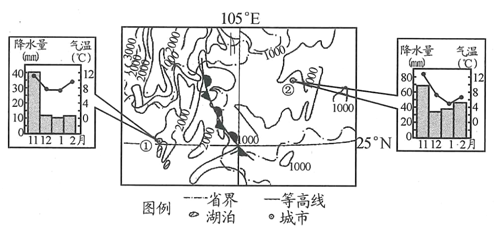(22分)下图为我国某区域等高线及天气气候资料图,读图回答问题。

(1)说明该区域的主要地貌类型和地表起伏状况,并说明地貌成因。(6分)
(2)简述图中天气系统的形成原因(6分)
(3)据图中信息描述①、②两城市该时期气候特征的主要差异及成因。(10分)
(1)喀斯特地貌广布 地表崎岖 该地为云贵高原,石灰岩分布广,经流水溶蚀作用形成。(6分)
(2)冬季来自北方的冷空气与西南气流相遇形成锋面;(2分)由于云贵高原地势西高东低;(2分)锋面在向西运动中受地形阻挡静止下来,形成准静止锋。(2分)
(3)该时段①城气温总体较②城高,温差较②城小,(2分)降水较②城少。(2分)原因是①城位于该天气系统(准静止锋)暖气团一侧,受锋面影响小,温暖如春;(2分)②城位于冷气团和锋面控制区域,受其影响大,阴雨冷湿;(2分)且①城纬度较②城低。(2分)
题目分析:
(1)读图,根据经纬度,结合图中的海拔高度,可以判断图示区为云贵高原地区,主要地貌类型是喀斯特地貌。 云贵高原,石灰岩分布广,经流水溶蚀作用,地表崎岖。
(2)图中天气系统是准静止锋的符号,是由冬季来自北方的冷空气与西南气流相遇形成的锋面。由于云贵高原地势西高东低,锋面在向西运动中受地形阻挡静止下来,冷暖气团势力相当,相持不下,形成准静止锋。
(3)读气温曲线和降水柱状图,可见该时段①城气温总体较②城高,温差较②城小,降水较②城少。读图分析原因,可以发现①城位于该天气系统(准静止锋)暖气团一侧,且①城纬度较②城低,温暖如春。②城位于冷气团控制区域,受其影响,气温较低。根据锋面降水特点,暖锋降水在锋前,即在②一侧,冷锋降水在锋后,也是在②一侧,所以②处阴雨冷湿,降水多。①处降水少。
